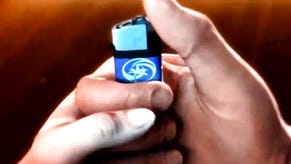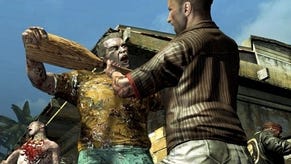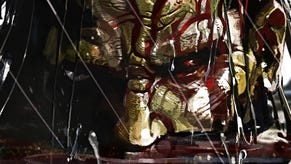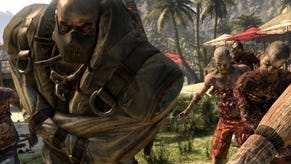Face-Off: Dead Island Riptide
Tropical storm.
| - | Xbox 360 | PlayStation 3 | PC |
|---|---|---|---|
| Disc Size | 3.4GB | 2810MB | Steam Download |
| Install | 3.4GB (optional) | - | 5.83GB (mandatory) |
| Surround Support | Dolby Digital | Dolby Digital, DTS, 5.1LPCM, 7.1LPCM | Set-up dependant |
Polish developer Techland is back, once again utilising its own Chrome Engine 5 to bring Dead Island's lush tropical environments to life. Attractive, expansive and dripping with detail, Riptide is an effective work-out for the bespoke technology, also seeing an increase in overall enemy count and better realising a world overrun by flesh eating monstrosities. The studio has also taken on-board criticism levelled at the first game in other areas: Dead Island Riptide is a noticeable more polished release, with far fewer of the infuriating glitches that previously tarnished the experience. The result is a smoother, more complete journey into the zombie apocalypse.
However, the improved level of quality control doesn't quite extend across all platforms: the Xbox 360 and PC releases possess fewer technical issues than the first Dead Island - in fact we rarely had any problems with them at all. However, it's very much a different story on the PS3: random events fail to trigger after completing certain missions, performance is generally shoddy, and this is joined by a new freezing glitch that significantly impacts upon the game on a regular basis. It's a bitter pill to swallow considering that this version - in common with the original Dead Island - features a small selection of tangible visual advantages over both the 360 and PC releases.
As you might expect, initial impressions reveal plenty of similarities with the original game from a visual perspective, from the core rendering resolution to the way certain effects are deployed across each platform. A look at our head-to-head videos below and the ubiquitous triple-format 720p comparison gallery reveals some clear differences in these areas, with the PS3 version once again featuring the better image quality of the two console releases, despite faring worse in other areas.
"PS3 has minor resolution and texture filtering advantages, but suffers in terms of visual features and frame-rate."
Alternative comparisons:
The core rendering set-up should be familiar to anyone who has played the previous game: Riptide renders natively at 720p on the PS3, taking a slight hit down to 1200x720 on the Xbox 360. However, this time around the use of post-process anti-aliasing has been jettisoned completely and neither version runs with any kind of AA solution. On the plus side, Riptide appears sharper than the original Dead Island as a consequence, with the slight texture blur caused by the post-process edge-smoothing nowhere to be found. The trade-off is that jaggies and edge shimmering are even more apparent now in both foliage and geometry-based structures. These side effects are a little more noticeable on the 360, due to the small upscale taking place that leaves that release looking slightly softer and less pristine than the other versions of the game.
Disappointingly, anti-aliasing is also absent on the PC game, although running in 1080p and higher resolutions does help to partially mitigate the appearance of jaggies and other artifacts. However, edge-smoothing can be applied manually via the use of injectors, allowing players to take advantage of post-process anti-aliasing solutions (such as FXAA) in order to improve image quality. This is a perplexing state of affairs that leaves the PC version feeling a little bereft of the kind of TLC the platform really deserves. At least Techland has included a v-sync option this time around, allowing the user to cap the frame-rate and prevent any unwanted tearing.
Upgrades in other areas are similarly limited, though still bring additional clarity and detail to the PC game: higher resolution textures and normal maps are found on some surfaces - on rocks and clothing, for example - enhancing the look of characters and the surrounding environments, while higher quality shadows feature smoother edges with less visible dithering artifacts. For the most part, the differences aren't particularly noteworthy, and we get the feeling that little has been done to properly take advantage of the vastly more powerful hardware available on today's gaming PCs in comparison to the seven-year-old tech present in the current-gen consoles.
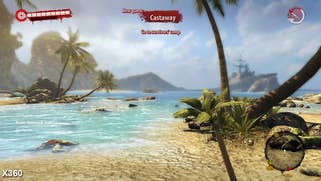
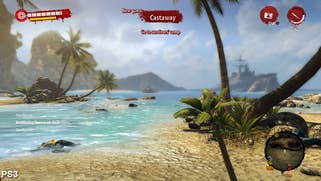
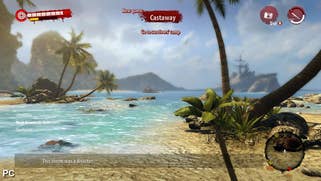

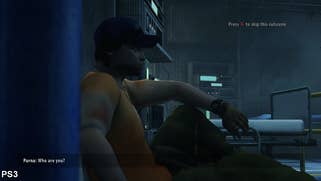

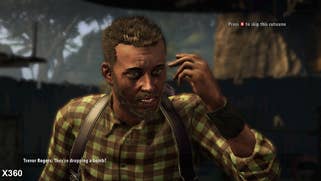

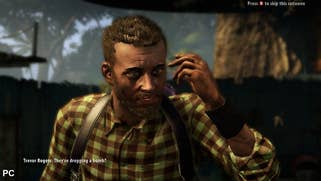



Some odd technical choices are also carried over from the previous game: low resolution alpha effects are present on all three platforms, while in some areas the PC version is actually at a disadvantage to the PS3 release. Texture filtering is actually better on Sony's system compared to the other platforms (360 and PC appear identical), which results in finer details appearing clearer and more pronounced from a distance on this version - something that we also saw in the original Dead Island.
Both console releases are closely matched with regards to the core artwork and the rendering of alpha buffers - none of the rich foliage or the intricate nature of the environments have been visibly pared back on either machine. The tropical landscapes on offer regularly feature some impressive views of the jungle and surrounding islands, with long draw distances helping to convey the size and scale of the environments. Despite this, a few of the more bandwidth heavy graphical effects have been downgraded or removed from the PS3 game, perhaps to deal with some severe performance issues in more alpha-heavy situations.
The biggest difference between the two console releases comes with the removal of the reflective water effects found on the 360 and PC on characters and the environment in stormy weather conditions. The effect seems to use animated normal maps with a specular layer to simulate rain being blown over various surfaces, helping to give these scenes a visibly wetter look. Elsewhere, lighting is slightly washing out on PS3 in certain scenes, while the level of specular reflection on various water surfaces appears to have been reduced. Other differences you might see in our assets - such as the way some scenes are lit and shaded - are down to the use of a real-time lighting system which dynamically illuminates the environment, casting shadows in different places. In addition, scripted weather conditions that occur in specific locations also have a dramatic impact on how some scenes are realised.
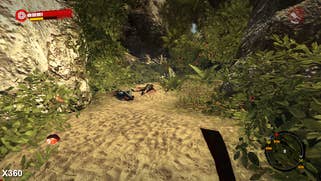
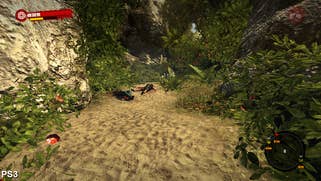

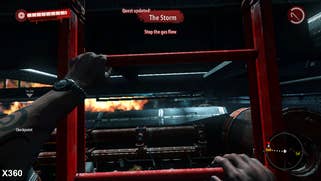
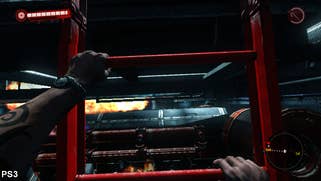
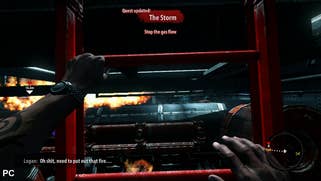
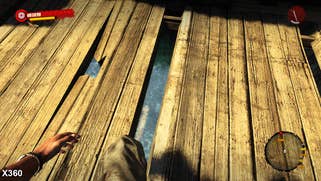
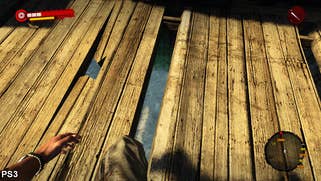
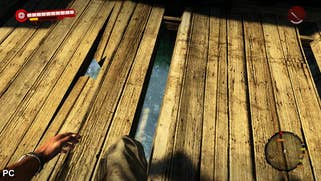
As you might expect in an open world title, streaming issues are a factor to take into account in Dead Island Riptide. Transitions between different detail levels for foliage, shadows, and geometry frequently come into view during gameplay, although these are mostly smooth due to the blending between LOD (level of detail) models. All three versions appear be on a par, with the subtle differences impossible to spot outside of like-for-like comparisons. On the other hand, during the cut-scenes we see the PC game featuring an advantage over the consoles, with hardly any visible LOD swapping. On the consoles, assets take longer to stream in during cut-scenes on the PS3 - an area where Sony's system previously had a clear advantage over the 360 in the original Dead Island.
Dead Island Riptide: performance analysis
In terms of performance, the original Dead Island targets a 30FPS update, but suffers from frequent frame-rate drops and plenty of screen-tear. This is particularly evident on PS3, where the constant fluctuations in smoothness lead to the controls feeling heavier and less responsive than 360 or PC. In comparison, frame-rates are much smoother on the 360, with tearing being by far the biggest problem.
The opening of Dead Island Riptide presents a bleak view of the proceedings on both consoles due to some horrendous performance issues which see frame-rates tumbling down to the low 20s with plenty of screen-tear to boot. The 360 manages anything up to an 8FPS lead at times, while the PS3 game drops down to around 18FPS at various points. It's an awful sight to behold on both systems and the game verges on being unplayable at times - more so on PS3. In outdoor scenes, the gap closes significantly with higher frame-rates on both platforms, although performance is still sub-par with sluggish controls and a continuously jerky update. Quite frankly, both versions are shockingly bad here, and the lack of stability ruins the game's opening moments.
Thankfully, after the opening chapter the situation stabilises somewhat on both platforms, more closely matching the metrics seen in the original Dead Island game. The 360 actually manages to maintain a fairly smooth update close to the desired 30FPS in various scenes where many zombies are present on screen, at the expense of some heavy tearing. In comparison, when faced with similar situations, performance is more heavily impacted on the PS3, leading to a considerable drop in fluidity and a hit to image consistency. In demanding scenes, it's common to see the PS3 game hover around the mid-20s while tearing, often delivering a presentation that is actually a downgrade from the first Dead Island release.
"Frame-rates are hardly exemplary on either platform, but Xbox 360 is clearly smoother and doesn't have the bizarre split-second freezing bug found in the PS3 game."
The situation is made worse on Sony's system by a bug which causes the game to frequently freeze for a split-second or so at seemingly random points, often every minute or so during gameplay. However, the frequency of the issue varies considerably: during the opening prologue and beginning of chapter one, we barely encountered the problem, and never experienced it during the cut-scenes. We also tested both the retail version and the PSN download of the game on two different PS3s, but both appeared to be equally affected by the problem. Other user reports online also suggest that the issue is game-related rather than anything to do with hardware.
Ultimately, it's clear that the 360 version of Dead Island comes across as the more stable of the two, with performance issues that are less impactful on the overall gameplay experience. That said, there are times when both systems manage to maintain a mostly solid 30FPS in less frenetic combat encounters, and in less detailed locations with fewer effects. However, the appearance of regular freezes on the PS3 is still very distracting - especially when they occur in quick succession. These glitches regularly materialise on a seemingly random basis, even when performance is otherwise solid.
Control issues were a major complaint levelled at the original Dead Island, and it's something that carries over to this sequel: turns using the analogue sticks feel heavy, while melee attacks are slow to respond when pushing down on the triggers. The fluctuating frame-rate in combination with relatively high input latency is the issue here, but thankfully the PC version allows us to mostly overcome these problems. Running Dead Island Riptide at 60FPS transforms the experience considerably, making the controls feel crisper and the action more fluid. In comparison, playing the game at a stable 30FPS gives us a similarly sluggish feel to that of the console releases.
Achieving 60FPS on a variety of high resolutions was no problem for our vintage Lynnfield Core i5 and Radeon 7870 set-up, with frame-rates only dipping very slightly in 1080p when the action was situated in more detailed environments packed with zombies. Owners of lower-spec PCs should be able to achieve 720p60 with relative ease, minus a few small blips in more demanding scenes.
"Riptide PC is the best version of the game overall - higher res and smoother frame-rates make all the difference."


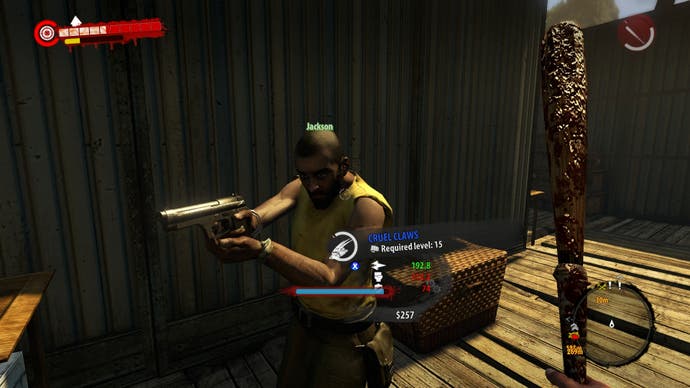
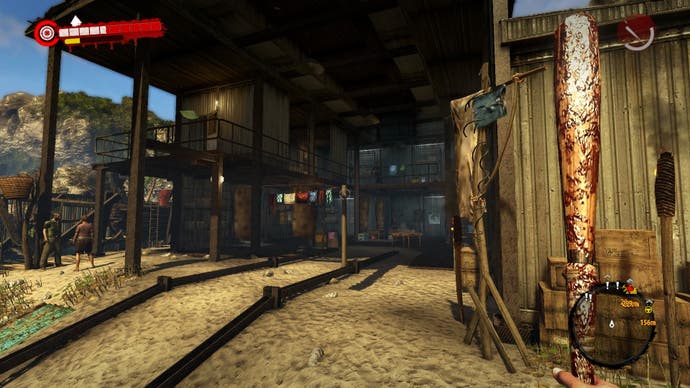
Dead Island Riptide: the Digital Foundry verdict
There's no doubt that Dead Island Riptide represents a clear improvement over the first game on the 360 and PC, both technically and in terms of game design. Sure enough, the changes made for this latest instalment feel more like tweaks intended for a smaller download package, but most of the familiar elements - from combat to weapon customisation - are handled better than before, even if much of the experience feels like a retread of past events set in a new location. In that sense, there are a lot of great ideas waiting to be fleshed out in this series, but Riptide isn't the game to do these concepts justice. Techland's latest still feels undercooked, and perhaps in need of a bit more focus.
The lack of polish in relation to the PS3 build is also disappointing: the erratic freezing bug and the various gameplay related glitches should have been easily picked up in the QA process long before Riptide was due to ship. Hopefully, the developer will release a post-launch patch to take care of these issues and bring the PS3 game closer into line with the other versions. It's a shame because Dead Island really comes alive as a multi-player game, where the paper-thin story and lack of character development isn't really an issue compared to the joy of mercilessly hacking down the rotting undead with some entertaining collective banter.
But right now, out advice is to avoid the PlayStation 3 build - at least until it has been patched. Owners of both consoles should opt for the Xbox 360 release, where smoother frame-rates and the more stable nature of the game simply make it more enjoyable to play. Meanwhile the PC version is the best buy overall if you own a relatively capable gaming computer and have access to a decent online friends list.




